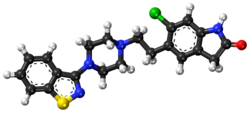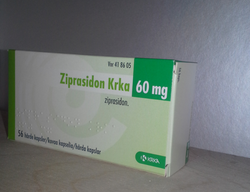 | |
 | |
| Clinical data | |
|---|---|
| Trade names | Geodon, Zeldox, Zipwell, other |
| AHFS/Drugs.com | Monograph |
| MedlinePlus | a699062 |
| License data |
|
| Pregnancy category |
|
| Routes of administration | By mouth, intramuscular injection (IM) |
| Drug class | Atypical antipsychotic |
| ATC code | |
| Legal status | |
| Legal status | |
| Pharmacokinetic data | |
| Bioavailability | 60% (oral)[3]
100% (IM) |
| Metabolism | Liver (aldehyde reductase) |
| Elimination half-life | 7 to 10 hours[4] |
| Excretion | Urine and feces |
| Identifiers | |
| |
| CAS Number | |
| PubChem CID | |
| IUPHAR/BPS | |
| DrugBank | |
| ChemSpider | |
| UNII | |
| KEGG | |
| ChEBI | |
| ChEMBL | |
| CompTox Dashboard (EPA) | |
| ECHA InfoCard | 100.106.954 |
| Chemical and physical data | |
| Formula | C21H21ClN4OS |
| Molar mass | 412.94 g·mol−1 |
| 3D model (JSmol) | |
| |
| |
| (verify) | |


Ziprasidone, sold under the brand name Geodon among others, is an atypical antipsychotic used to treat schizophrenia and bipolar disorder.[5] It may be used by mouth and by injection into a muscle (IM).[5] The IM form may be used for acute agitation in people with schizophrenia.[5]
Common side effects include tremors, tics, dizziness, dry mouth, restlessness, nausea, and mild sedation.[6][7] Although it can also cause weight gain, the risk is much lower than for other atypical antipsychotics.[8] How it works is not entirely clear but is believed to involve effects on serotonin and dopamine in the brain.[5]
Ziprasidone was approved for medical use in the United States in 2001.[5] The pills are made up of the hydrochloride salt, ziprasidone hydrochloride. The intramuscular form is the mesylate, ziprasidone mesylate trihydrate, and is provided as a lyophilized powder. In 2020, it was the 282nd most commonly prescribed medication in the United States, with more than 1 million prescriptions.[9][10]
- ^ "FDA-sourced list of all drugs with black box warnings (Use Download Full Results and View Query links.)". nctr-crs.fda.gov. FDA. Retrieved October 22, 2023.
- ^ Anvisa (March 31, 2023). "RDC Nº 784 - Listas de Substâncias Entorpecentes, Psicotrópicas, Precursoras e Outras sob Controle Especial" [Collegiate Board Resolution No. 784 - Lists of Narcotic, Psychotropic, Precursor, and Other Substances under Special Control] (in Brazilian Portuguese). Diário Oficial da União (published April 4, 2023). Archived from the original on August 3, 2023. Retrieved August 16, 2023.
- ^ Mattei C, Rapagnani MP, Stahl SM (February 2011). "Ziprasidone hydrocloride: what role in the management of schizophrenia?". Journal of Central Nervous System Disease. 3: JCNSD.S4138. doi:10.4137/JCNSD.S4138. PMC 3663608. PMID 23861634.
- ^ Nicolson SE, Nemeroff CB (December 2007). "Ziprasidone in the treatment of mania in bipolar disorder". Neuropsychiatric Disease and Treatment. 3 (6): 823–834. doi:10.2147/NDT.S794. PMC 2656324. PMID 19300617.
- ^ a b c d e "Ziprasidone Monograph for Professionals". Drugs.com. American Society of Health-System Pharmacists. Retrieved May 8, 2019.
- ^ Cite error: The named reference
TGA-Zeldox-IMwas invoked but never defined (see the help page). - ^ Cite error: The named reference
TGA-Zeldoxwas invoked but never defined (see the help page). - ^ Cite error: The named reference
PsychDrugsCommwas invoked but never defined (see the help page). - ^ "The Top 300 of 2020". ClinCalc. Retrieved October 7, 2022.
- ^ "Ziprasidone - Drug Usage Statistics". ClinCalc. Retrieved October 7, 2022.